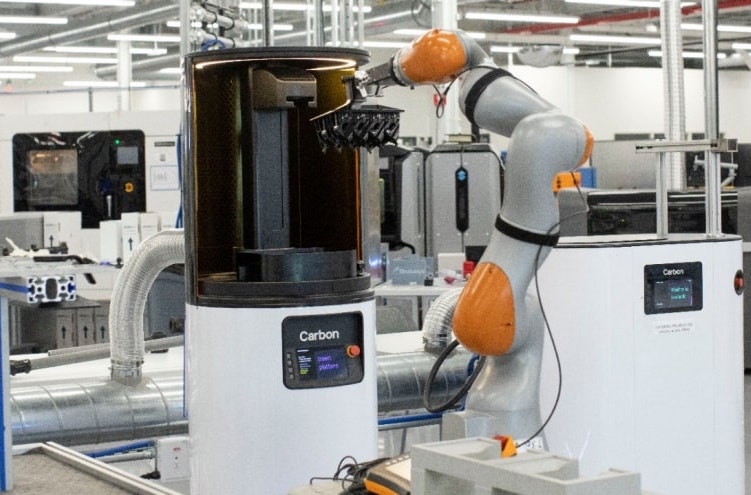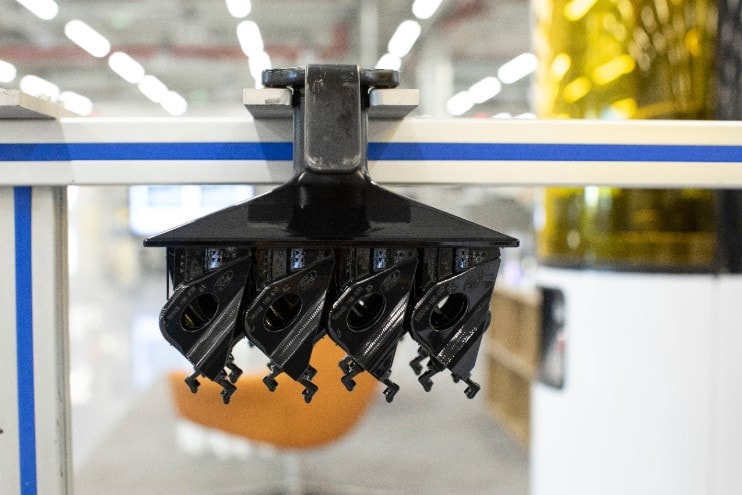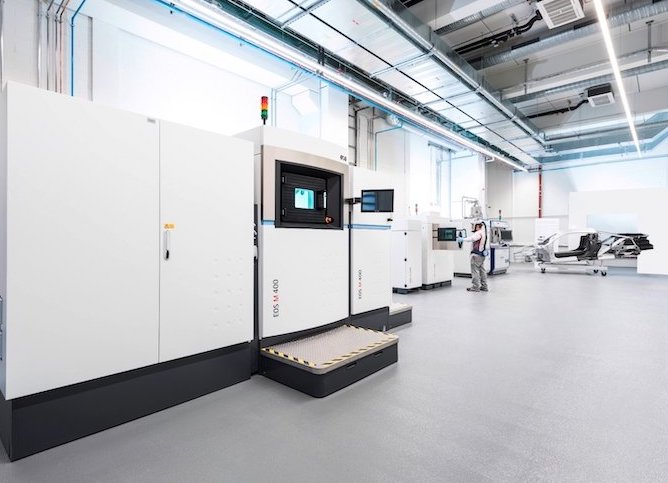Multinational automotive manufacturer Ford has begun using an autonomous robot within its production line to 3D print end-use parts for its vehicles.
Leveraging an in-house-developed interface, Ford has managed to get the KUKA-built bot to ‘speak the same language’ as its other systems, and operate them without human interaction. So far, the firm’s patent-pending approach has been deployed to 3D print custom parts for the Mustang Shelby GT500 sports car, but it could yet yield efficiency savings across its production workflow.
“This new process has the ability to change the way we use robotics in our manufacturing facilities,” said Jason Ryska, Ford’s Director of Global Manufacturing Technology Development. “Not only does it enable Ford to scale its 3D printer operations, it extends into other aspects of our manufacturing processes – this technology will allow us to simplify equipment and be even more flexible on the assembly line.”

3D printing at Ford’s innovation hub
Since acquiring an SLA 3 system back in the late 1980s, Ford has consistently sought to integrate 3D printing into different aspects of its vehicle production process. As revealed in a recent interview with AMUG keynote speaker Ellen Lee, the firm uses the technology, not just within fluid flow visualization and wind tunnel testing, but in the creation of jigs, fixtures and end-use components for its cars.
Much of Ford’s work around 3D printing takes place at its Advanced Manufacturing Center (AMC), a facility that now houses SLA, FDM and SLS systems, among a range of other advanced machinery. While the AMC team spends a lot of time verifying the feasibility of printed parts or assessing how technologies like 3D printing can be better utilized, their work has yielded a number of recent breakthroughs.
Just last month, Ford released CAD files that enable its customers to 3D print pickup truck accessories such as cup holders or phone mounts, and through working with HP last year, it developed a means of recycling 3D printing waste into F-250 parts.
Going further back, the company also partnered with DLS specialist Carbon in 2015, as a means of initially expediting its prototyping workflow, but with the longer-term goal of using the technology for part production. With the news that it has developed an automated Carbon 3D printing workflow, it now appears that Ford has passed this milestone, and set its sights on driving efficiency from the process.

Interfacing with autonomous robots
Like most companies, Ford utilizes systems at its production facilities that have been developed separately from one another, hence they don’t run the same interface and can’t usually communicate back and forth. However, the firm has now shifted this paradigm, by developing a unique application interface program that enables systems of different makes to send constant feedback to each other.
When applied to the robotic arm on wheels housed at Ford’s AMC, which it has nicknamed ‘Javier,’ the software essentially allows it to ‘talk to’ the Carbon 3D printers there. As a result, the bot is now able to tell when the center’s additive manufactured parts will be finished, as well as when they’re ready for pick-up, operating autonomously all night long without requiring any human input at all.
Although Ford admits that its operators are still responsible for uploading designs to the printer and maintaining machinery, it says its approach does unlock higher part throughputs and reduces related costs. The firm also claims to have used Javier’s feedback to reduce the margins of error within its processes, allowing it to “achieve great accuracy” in production despite the bot not having the vision systems to ‘see.’
At present, the company is utilizing its setup to make low-volume, custom parts such as a brake line bracket for the Performance Package-equipped version of its Mustang Shelby GT500. Moving forwards though, Ford believes its program could be applied to make other robots in its production line more efficient as well, and it has filed several patents, not just on its interface, but the positioning of its KUKA bot.

The competitive world of automotive AM
Due to the highly-competitive nature of the automotive industry, we may not know the full extent to which many leading manufacturers utilize 3D printing, but now and then they do provide us with a glimpse of the way it’s used behind the scenes.
Back in June 2021, it was revealed that Volkswagen has adopted binder jetting at its main plant in Wolfsburg, Germany. Working as part of a project that reportedly made it the first car maker to deploy the technology within its production process, the firm has partnered with HP and Siemens with the aim of driving greater efficiency and part throughput there.
Similarly, fellow car-manufacturing multinational Groupe Renault has announced plans to integrate 3D printing capabilities into its new sustainable automotive ‘Re-Factory.’ Specifically, the company says that the complex, which is set to focus on reducing waste by recycling and retrofitting vehicles, will feature a spare part additive manufacturing service.
At Audi’s Metal 3D Printing Centre in Ingolstadt, meanwhile, its engineers have begun ramping up their deployment of EOS technologies to 3D print hot form tooling. In doing so, the firm says it’s now able to produce twelve different segments of four hot forming tools at the facility, which are later used to assemble car models like the A4 saloon.
To stay up to date with the latest 3D printing news, don’t forget to subscribe to the 3D Printing Industry newsletter or follow us on Twitter or liking our page on Facebook.
For a deeper dive into additive manufacturing, you can now subscribe to our Youtube channel, featuring discussion, debriefs, and shots of 3D printing in-action.
Are you looking for a job in the additive manufacturing industry? Visit 3D Printing Jobs for a selection of roles in the industry.
Featured image shows Ford’s ‘Javier’ autonomous 3D printing robot. Photo via Ford.
